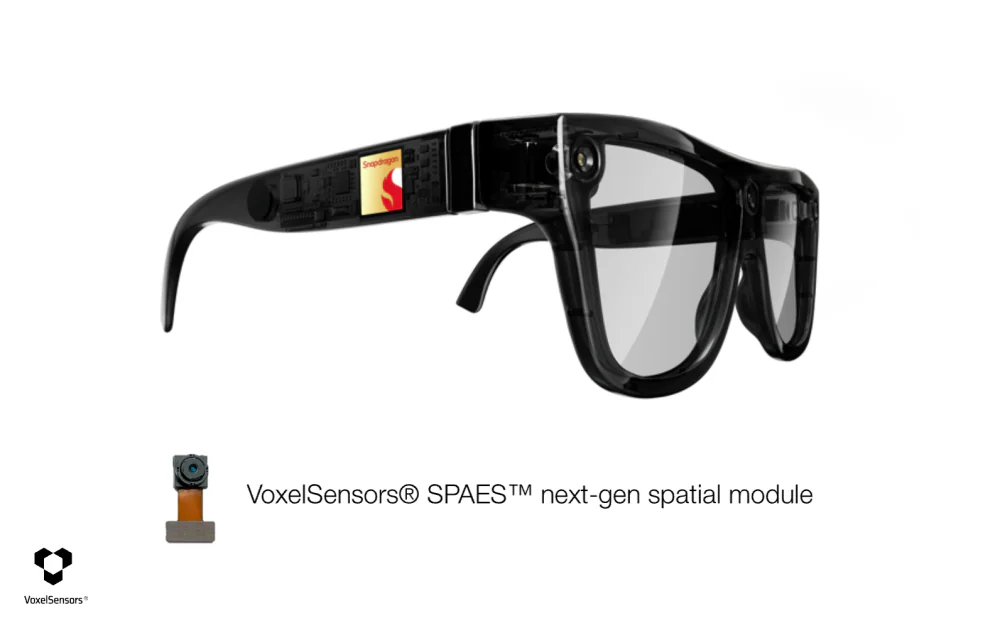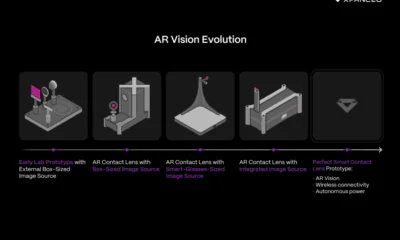Technology
VoxelSensors and Qualcomm Join Forces to Redefine AR Glasses

Augmented reality (AR) has long promised a future where lightweight glasses seamlessly overlay useful digital information onto the real world. But despite years of progress, most AR devices today remain bulky, power-hungry, and inconsistent in real-world conditions. For AR to move beyond niche use cases and into the mainstream, the technology powering these devices needs a serious leap forward.
That is exactly what VoxelSensors, a Belgian deep-tech startup, is aiming to deliver. The company announced a new collaboration with Qualcomm Technologies to integrate its Single Photon Active Event Sensor (SPAES™) and PERCEPT contextual AI platform into the Snapdragon AR2 Gen 1 platform, Qualcomm’s flagship chipset for AR glasses.
The goal is clear: smaller, lighter, and more intelligent AR glasses that consumers can wear all day — a step closer to finally making AR a practical part of everyday life.
Why Current AR Glasses Fall Short
For all their promise, today’s AR devices still fall short of expectations. Battery life is one of the most persistent problems; the sensors and processors that make AR possible consume so much power that most devices only last a few hours before needing a recharge. Reliability is another barrier. Many of the common sensing approaches — from structured light to stereo cameras — fail under everyday conditions, whether it’s bright sunlight, flat surfaces with little texture, or dim indoor settings. To compensate, manufacturers often add extra hardware, which leads to bulkier devices that are uncomfortable to wear for long stretches of time.
The result is a category that excites with demos but struggles to prove practical in everyday use. Solving these issues is what VoxelSensors has set its sights on.
SPAES™: A New Kind of Sensor
VoxelSensors’ breakthrough is its SPAES™ technology, a sensing system built on event-based single-photon detection. Unlike traditional cameras that capture entire frames of data, SPAES detects only the changes that matter, processing information at the level of individual photons. This approach dramatically reduces the amount of data collected while improving the speed and efficiency of the system.
The benefits are significant. SPAES can deliver depth sensing at ten times lower power consumption than current methods while responding over a hundred times faster than frame-based systems. Perhaps even more important, it continues to perform reliably in both bright outdoor light and low-light indoor environments, where other systems typically fail. This combination makes it possible to imagine AR glasses that are responsive, accurate, and capable of lasting through an entire day on a single charge.
From Raw Data to Real Understanding
Of course, capturing raw information is only half the challenge. To be useful, AR devices need to understand the context of what the user is doing. This is where VoxelSensors’ PERCEPT platform comes into play. PERCEPT is an AI-driven analysis layer that interprets the world from the user’s point of view. It can determine not only where the user is but also what they are paying attention to, how they move through their environment, and how they interact with objects around them.
At the core of PERCEPT is a mechanism VoxelSensors calls Triage. This system prioritizes relevant information and filters out noise, ensuring that the device focuses only on what matters most to the user in a given moment. By suppressing irrelevant data, PERCEPT reduces energy use, protects user privacy, and creates cleaner signals that can train AI models more effectively. The combination of SPAES and PERCEPT results in what VoxelSensors calls Physical AI — artificial intelligence rooted in human perspective. Instead of simply displaying digital overlays, AR glasses can begin to anticipate user needs, offering assistance that feels more personal and adaptive.
Qualcomm’s Role: Snapdragon AR2 Gen 1
While VoxelSensors brings new sensing innovations, Qualcomm provides the processing backbone to make them usable at scale. Qualcomm’s Snapdragon AR2 Gen 1 platform is designed specifically for AR devices, with specialized AI acceleration, efficient compute, and seamless connectivity. By optimizing SPAES and PERCEPT to run on Snapdragon, VoxelSensors ensures its technology integrates smoothly with the platform that many of today’s AR device makers already depend on.
The collaboration creates a full sensing-to-compute pipeline: SPAES captures the world at unprecedented efficiency, PERCEPT interprets the data in real time, and Snapdragon executes the processing needed to translate that into fluid AR experiences. According to Qualcomm’s Ziad Asghar, this is exactly what is needed to achieve the vision of “small, lightweight AR smart glasses that consumers can wear all day”.
The companies plan to make the optimized solution available to select partners by December 2025, marking an important step toward commercial deployment.
A Shift in What AR Glasses Can Do
What makes this collaboration stand out is how it shifts the function of AR glasses from being just display devices to becoming intelligent companions. With SPAES handling multiple tasks — from depth perception and eye tracking to micromotion imaging and controller tracking — glasses no longer need a patchwork of different sensors. Everything is anchored to the user’s own viewpoint, reducing design complexity while improving accuracy and efficiency.
For device makers, this means fewer components to integrate, simpler manufacturing processes, and ultimately smaller, lighter glasses that consumers will actually want to wear. For users, it means AR experiences that feel smoother, more responsive, and more aligned with their real-world behavior.
Toward Everyday AR
The potential applications for this technology extend far beyond gaming or entertainment. In healthcare, AR glasses could assist surgeons by providing reliable contextual awareness during procedures. In education, they could enable personalized learning experiences that adapt to where students focus their attention. For workers in fields like logistics or manufacturing, they could provide hands-free guidance in complex environments. Even for everyday consumers, the promise is compelling: a discreet personal assistant that understands not just voice commands, but the context of what the wearer is doing and seeing.
VoxelSensors describes this transition as moving from “pixels to data, and data to perception”. Instead of simply projecting digital information, AR glasses begin to interpret and respond to the physical and human context in real time.
A Deep-Tech Startup with Proven Roots
Although founded in 2020, VoxelSensors builds on a deep legacy of innovation. Its founders previously worked at SoftKinetic, a time-of-flight sensing company acquired by Sony, and in 2024 the company acquired the intellectual property of EyeWay Vision, further strengthening its technology portfolio.
VoxelSensors has also positioned itself within the broader policy and innovation ecosystem. As a founding member of the EU Virtual Worlds Public-Private Partnership, the company is helping to shape Europe’s strategy for virtual and augmented technologies. Its alignment with the EU AI Act and Web 4.0 strategy underscores its commitment to privacy, inclusivity, and responsible innovation — qualities that may prove crucial as AR adoption grows and data practices come under increasing scrutiny.
Looking Ahead
The coming years will determine whether AR glasses can transition from futuristic prototypes to truly practical consumer devices. VoxelSensors’ roadmap emphasizes further miniaturization of sensors, deeper integration with Snapdragon platforms, and expanded edge AI capabilities to ensure responsiveness and privacy are maintained on-device.
If successful, the collaboration between VoxelSensors and Qualcomm could mark the beginning of a new era in AR: one where glasses are not only slim and efficient but also intelligent enough to understand the world from the wearer’s perspective. That shift could turn AR from a technology of flashy demos into a tool as ordinary — and as indispensable — as the smartphone.












